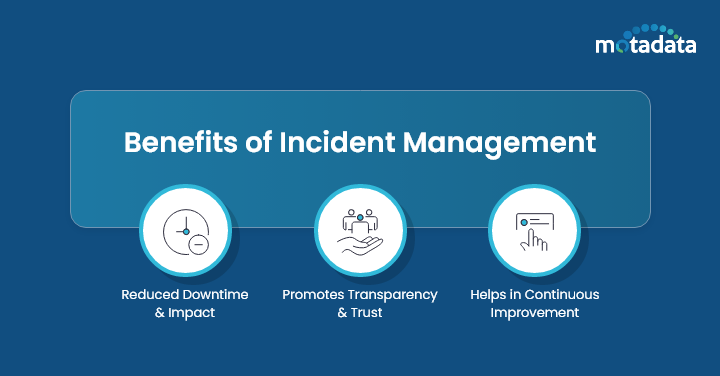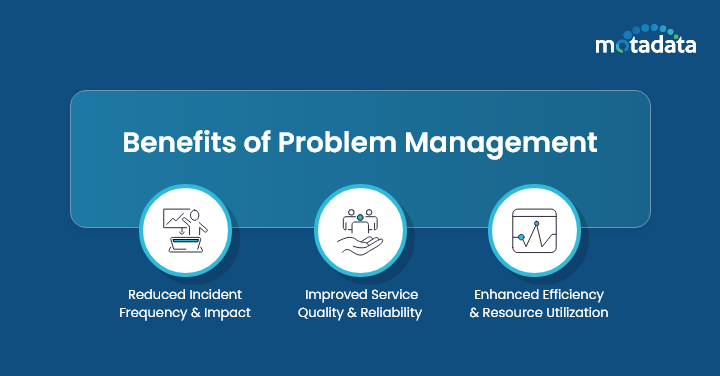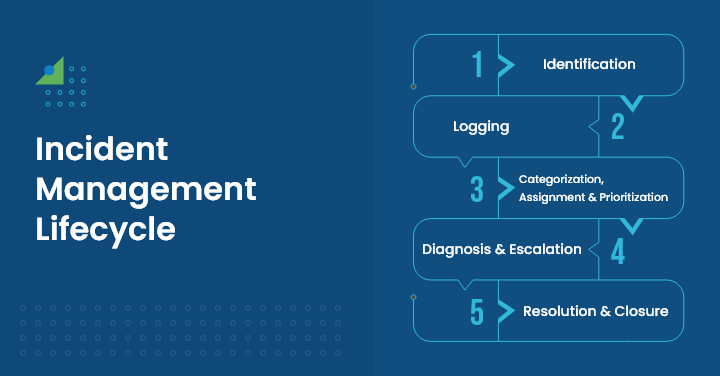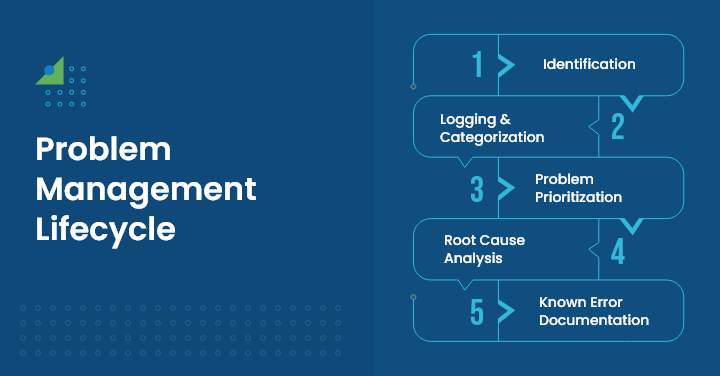Have you ever encountered two concepts that overlap so much that they are interchangeably used?
It can be challenging to distinguish their distinct roles. Incident and problem management are two such concepts in IT service management.
For a long time, organizations treated incident management and problem management as different concepts, each playing a specialized role.
As software development and operations became less siloed through practices like DevOps, the lines between incident and problem management blurred.
To understand both these management types and their differences, we’ll explore their interrelatedness and much more in great detail.
What is Incident Management?
Incident management is a process for responding to unexpected events that disrupt operations in real-time.
The process focuses on restoring services to their normal operational state as fast as possible, ensuring little to no adverse impact on business operations.
A hypothetical example of incident management would be a sudden server failure in a company that disrupts all operations.
In this case, incident management addresses the issue by promptly activating backup servers and reducing downtime.
What is Problem Management?
Problem management is a process used to identify and eliminate the root causes of an incident within IT services.
The process focuses on determining the underlying causes of an incident and managing them to prevent future occurrences.
A hypothetical example of problem management would be resolving a glitch in critical security software that negatively impacts company workflows.
In this case, problem management is used to identify the cause (poor coding) and then build an improvized code to avoid further glitches.
Incident Management vs. Problem Management – Are They Different?
Incident management and problem management practices are so interrelated that most consider them the same.
However, though the incident vs. problem management practices overlap, each has a distinct role.
Here are the key differences between the two.
| Aspects | Incident Management | Problem Management |
|---|---|---|
| Focus | Focuses on speed – prompt resolution to unexpected incidents | Focuses on detail – identifying and eliminating root causes of incidents |
| Purpose | Quickly restoring ongoing services | Addressing underlying issues to prevent future incident recurrence |
| Scope | Reactive and immediate incident resolution | Proactive and long-term solutions to incident prevention |
| Lifecycle processes | Identification, logging, categorization and prioritization, diagnosis, resolution, documentation, and closure | Identification, logging, categorization and prioritization, root cause analysis, error documentation, resolution, verification, and closure |
| Important metrics | Number of incidents, average time to resolve, escalation rate, response speed | Number of new problems, average time to fix, average time to diagnose |
| Important benefits | Minimizing downtime and impact | Enhancing service quality and reliability |
What is the Role of Incident Management and Problem Management?
Both incident and problem management work together to ensure efficiency in IT operations.
While incident management focuses on immediate solutions, problem management aims to prevent future incidents by identifying and addressing the root causes.
Consider an application that regularly breaks down, resulting in recurring service disruptions.
Here, incident management works reactively to address the incident when it occurs, and problem management works proactively to diagnose the causes of the breakdown and address them to prevent recurring incidents.
Problem management is important as it helps identify the single issue that might cause multiple incidents and nips them at the source to ensure prevention.
However, that doesn’t lower the importance of incident management.
While incidents in software development are inevitable, a solid incident management process ensures faster and more efficient incident resolution.
In the next section, we have discussed the benefits of incident vs. problem management to emphasize the importance of their roles in IT service management.
Benefits of Incident Management
Following the benefits of incident management that make its role crucial in ITSM:
1. Reduced Downtime and Impact
Research suggests that lost revenue from downtime in the IT industry spans from $145,000 to $450,000 per hour.
With a solid incident management process, companies can focus on quick resolution of incidents to minimize downtime.
For instance, addressing an application crash immediately prevents financial losses and reduces adverse impact on ongoing operations.
2. Promotes Transparency and Trust
A well-executed incident management process ensures transparency by keeping all stakeholders informed on the updates, ongoing issues, and their resolutions.
This promotes transparency between the management, IT teams, and customers, facilitating long-term success.
3. Helps in Continuous Improvement
Incident management helps gather quantitative feedback on incidents, like their impact, downtime, and frequency.
This data-driven approach enables teams to identify recurring issues, improve them, and implement preventive measures.
Benefits of Problem Management
Following are the benefits of problem management that show its importance in IT service management:
1. Reduced Incident Frequency and Impact
Problem management works to identify and eliminate the root cause of incidents, resulting in a decrease in incident frequency.
For instance, resolving the root cause of network issues can prevent the recurrence of outages and service disruptions.
2. Improved Service Quality and Reliability
Problem management focuses on a proactive approach, addressing the underlying problems that cause an incident. Thus, it helps enhance overall service quality and reliability.
For example, fixing software bugs proactively from their source helps improve overall software quality and user experience.
3. Enhanced Efficiency and Resource Utilization
Implementing problem management optimizes resource allocation as it focuses on long-term solutions instead of immediate ones.
For example, performing root cause analysis to evaluate and streamline processes can improve operational efficiency and team productivity.
What is the Incident Management Lifecycle?
IT service management uses a lifecycle approach to manage incidents.
Here are the key stages involved in incident management.
Step 1: Identification
The process begins with identifying an incident using monitoring tools or user reports.
It involves spotting disruptions in IT systems that demand attention.
Step 2: Logging
Once identified, incidents are logged with relevant details, such as the date, time, incident reporter’s name, ID, and other details. This documentation helps track incidents.
Step 3: Categorization, Assignment, and Prioritization
Incidents are categorized based on predetermined criteria and assigned to the right IT teams for resolution.
Further, teams perform incident assessments to evaluate the impact of the incident on operations and stakeholders and prioritize critical incidents that require immediate attention.
Step 4: Diagnosis and Escalation
This step involves preparing a hypothesis about the incident and quickly planning the steps for resolution. If required, the incident is escalated to specialist teams for quicker resolution.
Step 5: Resolution and Closure
In this step, IT teams implement solutions to address the incidents effectively and restore services as quickly as possible.
The last step is closure, where the stakeholders are informed that the incident has been resolved.
What is the Problem Management Lifecycle?
Problem management focuses on attention to detail, ensuring identification of the root cause that results in an incident.
It involves foreseeing issues and controlling them before they can occur.
Here are the typical steps involved in the problem management lifecycle.
Step 1: Identification
This step involves proactively identifying problems or root causes of an incident by performing a thorough analysis. Problem identification generally digs out the ‘whys’ in the incident.
Step 2: Logging and Categorization
Similar to incident management, problems identified in an incident are recorded and categorized based on specific criteria.
Step 3: Problem Prioritization
In this step, the IT teams prioritize problems based on the potential impact, damage, urgency, and required resolution period to ensure effective resource allocation.
Step 4: Root Cause Analysis
This is the most important step in problem management, which is why it is different from incident management.
This step is the key highlight of incident management vs. problem management.
It involves performing an in-depth analysis to determine the underlying causes of the incident and taking preventive measures.
Step 5: Known Error Documentation
After the root cause analysis, the next step is to document the known errors and their workarounds in a database for quick reference and problem-solving.
Step 6: Solution Design and Implementation
This step involves designing and implementing the solution to permanently resolve the identified causes.
Step 7: Verification and Closure
The final step involves verifying the implemented solution to see if it effectively solves the problem.
Thus, teams can close the problem records and inform stakeholders about the resolution.
The implemented solution is then monitored to ensure effectiveness, and continuous improvements are made to refine the solution further.
How Can Motadata Help in Incident Management vs. Problem Management?
When an unexpected incident occurs, teams run quick solutions to fix it. Once fixed, they deep dive into the underlying causes to ensure prevention.
In the end, it is not about incident management vs. problem management but more about how both concepts complement each other.
Implementing effective incident and problem management processes is relevant in modern-day organizations as both play distinct roles in increasing overall operational efficiency.
Want to ensure seamless incident and problem management implementation? Motadata can help.
Motadata’s incident management and problem management software can enhance the efficiency of your incident management process by automating ticket management, accelerating incident response time with SLA management, and easy monitoring of tickets using dashboards.
With Motadata’s problem management software, you can perform root cause analysis to gain greater visibility into system issues.
Automate workflows for faster resolution processes and integrate them with other ITSM processes, like change or asset management solution.
To learn more, try out Motadata now!
FAQs
A problem is the potential cause of one or multiple incidents, and an incident is an unplanned event that causes service disruption. A problem and an incident can be considered cause and effect. While the problem is the cause, the incident is the effect or outcome.
Incident management is a process that focuses on addressing incidents as they occur in real-time. It is a reactive approach to quickly fixing issues and reducing their impact on business operations. At the same time, problem management focuses on deeply analyzing an incident to identify and eliminate its underlying causes, preventing recurrence. It is a proactive approach to preventing the occurrence of incidents.
Prioritizing incidents based on their potential impact and urgency helps IT teams or incident specialists allocate resources like tech support or expert skills effectively. Proper allocation of resources based on priority enables prompt incident resolution.
Incident management and problem management processes work together. As incident management addresses incidents quickly to avoid service disruption, problem management deeply analyzes incidents to prevent them from recurring. Together, both processes tackle issues in the short term and the long term, ensuring efficient IT service management.
Organizations integrate incident and problem management with other ITIL processes like change management, asset management, and service desk operations using tools like Motadata.
Motadata’s problem management software integrates problem management with other ITSM processes to help ensure high service availability. The platform can also help you link similar incidents to a problem, implement change, and publish knowledgebase articles for reference.











